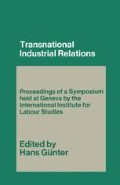Abstract
The rapid advance of our scientific knowledge and its technological applications have brought the role of massive research and development in economic growth into enhanced prominence. Figures, showing that the United States spends some fifteen to twenty times as much on research and development annually as a typical European State does, have been used to argue that most States in the world today are too small to be leaders in massive technology-oriented industries such as aerospace, applications of nuclear energy, and others. These technological pressures are said to be a force for the formation of regional entities larger than existing States in Europe and the Third World.
Access this chapter
Tax calculation will be finalised at checkout
Purchases are for personal use only
Preview
Unable to display preview. Download preview PDF.
Notes
George Modelski: ‘The Corporation in World Society’, Yearbook of World Affairs, 1968 ( London, Stevens, 1968 ), p. 68.
Raymond Vernon: ‘Economic Sovereignty at Bay’, Foreign Affairs XLVII (October 1968), p. 115.
J. J. Servan-Schreiber: The American Challenge (N.Y., Atheneum, 1968), ‘but Sweden has no ambition to be a world power’, p. 111.
André Beaufre: NATO and Europe ( N.Y., Vintage, 1966 ), p. 33.
Jean Gottmann: ‘Geography and International Relations’, in W. A. Douglas Jackson (ed.), Politics and Geographic Relationships ( N.Y., Prentice Hall, 1964 ), p. 28.
Albert Wohlstetter: ‘Illusions of Distance’, Foreign Affairs (January 1968), p. 250. Also, Institute for Strategic Studies: The Implications of Military Technology in 1970s (London, Adelphi Paper 46, 1968 ).
Pitman B. Potter: ‘Universalism Versus Regionalism in International Organisation’, American Political Science Review, XXXVIII (1943), p. 852.
John Herz: ‘The Rise and Demise of the Territorial State’, World Politics, IX (July 1957), pp. 473–93.
See Leon Lindberg: ‘Integration as a Source of Stress on the European Community Systems’, in J. S. Ney (ed.), International Regionalism ( Boston, Little, Brown, 1968 ).
Stanley Hoffman: Gulliver’s Troubles, or the Setting of American Foreign Policy (N.Y., McGraw-Hill, 1968).
See Raymond Vernon: ‘The Role of U.S. Enterprise Abroad’, Daedalus, XCVIIr (Winter 1969), p. 123.
Editor information
Editors and Affiliations
Copyright information
© 1972 The International Institute for Labour Studies
About this chapter
Cite this chapter
Nye, J.S. (1972). The Strength of International Regionalism. In: Günter, H. (eds) Transnational Industrial Relations. Palgrave Macmillan, London. https://doi.org/10.1007/978-1-349-01291-6_3
Download citation
DOI: https://doi.org/10.1007/978-1-349-01291-6_3
Publisher Name: Palgrave Macmillan, London
Print ISBN: 978-1-349-01293-0
Online ISBN: 978-1-349-01291-6
eBook Packages: Palgrave Business & Management CollectionBusiness and Management (R0)

